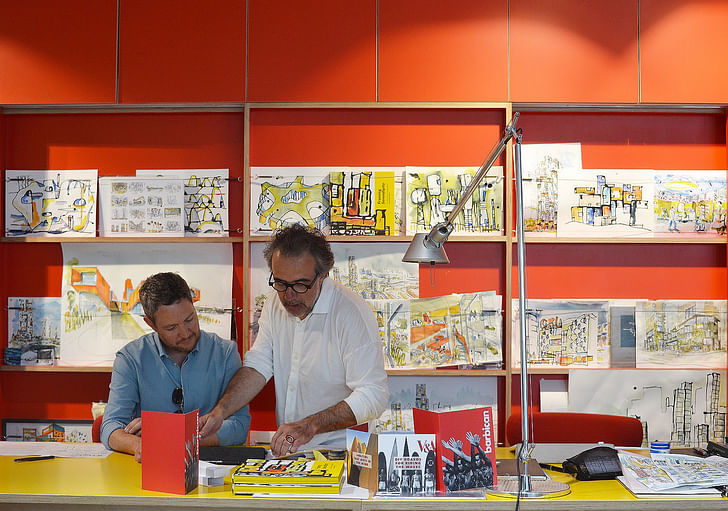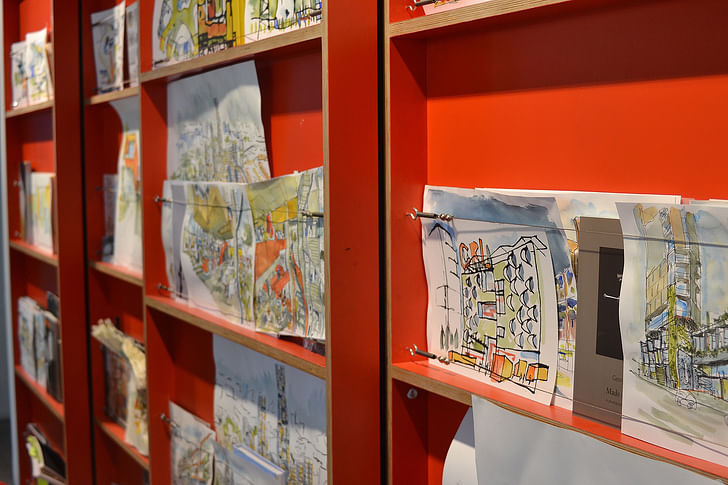

For our latest Studio Visit we went to see Studio Egret West, based in the heart of Clerkenwell.
Lone, the Studio Manager gave me the full tour after which David sat down with me to tell me more about the practice he founded with Christophe Egret nearly thirteen years ago.
Location?
David: Clerkenwell
When did the practice start?
David: November 2004
How many staff?
David: 60
Later David returned to this and specifies that they will stay at this number with a one in one out policy largely because “we want to be able to hire a coach (which is 62 people) at the drop of a hat. One time we went to Milan to Lake Iseo to see the Floating Piers, which was only on for two weeks, so it had to be spur of the moment. So we said ‘let’s go!’ and if there was more of us we couldn’t do that sort of thing.”


Company ethos?
David: One of the most important things to us is that we are a studio, with a studio environment, rather than an office environment. Any person that walks through the door here whether they are a client, collaborator, designer, a member of the community - they get that. We all design together, and it's been that way since we've been in this office.
Christophe is an architect and I am an urban designer. We were actually referred to as the odd married couple when we first started the company! Architecture doesn’t over power urban design and urban design doesn’t imbalance architecture. We are both involved to the same extent on every single project and we always have been. As we’ve grown older, grayer, we have appointed Lucas Lawrence, the third director, the third leg of the stool – which is a really helpful balance.
In the studio, we have architects, urban designers, landscape architects, graphic designers, model makers, all of whom are intrinsic to what we do and communicating our message. Gradually we are now weaving into interior design, product design, exhibition design, as we find more and more of our projects reach way beyond the normal bounds of what is considered architecture.
We believe in frameworks rather than masterplans. We believe masterplans are like straight jackets, out of date architectural thinking, we prefer the idea of frameworks as something much more flexible. Having set overarching structures we then are equally passionate about place, specificity of place and making sure that the interventions we design, often as the founding events of a new project, a new conjoined place are very very high in identity and memorable quality and set the tone for the next evolution of the place.
After much discussion, David and I ponder that the practice is reliant and revolves around three keys things (all conveniently beginning with ‘s’) strategy, specificity, and serendipity. Although I would add, and I think he would agree, a fourth ‘s’, the studio.
It is the studio’s open-mindedness, which we refer to as serendipity, that to us is as valuable a research stream as anything else and is our foundation.

Current projects?
David: We currently have 18 projects on site which is very stimulating for the practice. We have a number of large scale framework plans, the biggest one, is the Mayfield project in Manchester.
There are also numerous mixed-use projects we are working on and we just submitted planning for Preston barracks in Brighton. As well as lot of edge of town shopping centres projects which are particularly interesting as they are only 30 or so years old.
In addition, we are doing a lot of work on interchanges at the moment, aiding the, as we call it; platform to pavement to place. Also, we authored with London Underground the London Underground Station Idiom, which we have been working on for the last two years and is about to be formally launched.
We are just about to go on site at Balfron Tower too which is very exciting.

Favorite part of the studio?
David: Our showroom space, the shop window because it’s the thing that connects us to the wider community. It’s our ability to communicate with our own community beyond our architectural network.

Social Activities/Benefits?
David: Designers spend so much time in their working environment and they have chosen specifically to do that and we try to reward and acknowledge that by creating a very creative and flexible working environment. We ado a lot of activities together including:
We also have a sports masseuse!
Favourite nearby coffee shop?
David: We do have Allpress Coffee here, which is pretty nice to be honest. But if I do go out, I really like the coffee at Workshop.

Do you eat lunch together?
David: Yes, sometimes. When we were ten people, twenty people, we use to cook together every single day – there was a budget per head, and it would be someones turn and they would take that budget and go make an amazing meal for the entire studio at lunch time. We did that for the best past of five years.
Obviously, as we have grown to sixty now, which has happened very quickly over the past few years, it’s hard to do so. But we do do a lot of things together, lots of trips, celebrations, a monthly review with breakfast all together. Actually, we do have Christmas dinner here.


Pets allowed?
David: No.
Actually, I don’t know…
(Asks Christophe, who furiously nods his head)
Christophe: I would quite like a dog actually…
David surprised, seems fairly indifferent but concerned by the potential mess “you want a stinky wet hound”… a marital tiff ensues.
Most played song/artist/musician?
David: We always listen to Spotify, everyone has access, so it’s changing constantly, very often reflecting the mood of the office.
Favourite building in London?
After some deliberation, sighing, conferring…
David: The Barbican.


Ellen Hancock studied Fine Art and History of Art at The University of Leeds and Sculpture at Mimar Sinan Fine Arts University in Istanbul.Now based in London she has a keen interest in travel, literature, interactive art and social architecture.
No Comments
Block this user
Are you sure you want to block this user and hide all related comments throughout the site?
Archinect
This is your first comment on Archinect. Your comment will be visible once approved.